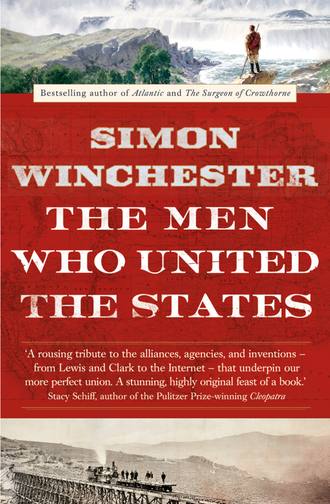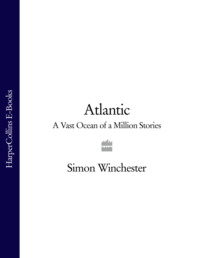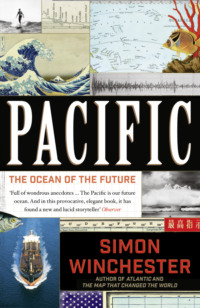
Полная версия
The Men Who United the States: The Amazing Stories of the Explorers, Inventors and Mavericks Who Made America
No one has the slightest idea of what Sacagawea looked like, though there has been much speculation and invention. Fanciful images of her—in oils, watercolors, mosaics, pastels, cartoons—are plentiful. The Iowa-born white all-American beauty Donna Reed played her in one older movie (with Charlton Heston playing Clark and Fred MacMurray as Lewis), and more recently a Japanese Cherokee actress named Mizuo Peck did so in two others. Sacagawea stamps, mountain peaks, and rivers abound. The eighteen best-known American statues8 of Sacagawea usually display a tall, robed woman of classically noble bearing, invariably carrying, papoose-style, the boy child she bore in camp in February 1805. His name was Jean-Baptiste, but the expedition members more familiarly called him Pomp. (Clark could never get his tongue around Sacagawea’s proper name and called her Janey instead.)
But while the artistic world might allow some license, the United States Mint is more severe in its demands. To present as accurately imagined a profile as possible for the gold-tinted Sacagawea dollar coin required some rather more intelligent speculation. The coin artist chosen by the Treasury eventually chose as her model a twenty-two-year-old college student named Randy’L He-dow Teton, a Shoshone from Idaho who won some lasting fame as the girl on the coin and has since become a motivational speaker for the American Indian cause.
By general consensus Sacagawea is thought to have been a Shoshone from the mountains of Montana or Idaho captured by a Hidatsa raiding party. Many others claim evidence that suggests quite the opposite: that she was a Plains Indian, a member of the Hidatsa tribe all along, who had actually been captured by Shoshone raiders and spirited back to their lair in the Rockies, from which she escaped and managed to get all the way back to the Plains with the help of (the story at this point somewhat straining belief) a party of sympathetic wolves.
To judge from the expedition diaries, in which Sacagawea is seldom named as anything but “the Squaw,” there is little evidence she did a vast amount for the explorers. There is no suggestion, in particular, that she enjoyed an affair with Clark, as Donna Reed so luridly did with Charlton Heston, though the fact she gave him two dozen white weasel tails as a Christmas present was apparently enough to set Hollywood’s imagination going. Her quick thinking may once have saved some of the expedition papers from getting waterlogged when one of the pirogues tipped over. She was helpful in recognizing parts of the Western landscape from her childhood memories, and she was able to nudge the scouts to cross a particular mountain pass she knew. She was helpful as a translator and interpreter of the Shoshone language and of those other tongues that were its linguistic kin, and she knew a little French, as did Captain Lewis.
Probably her most valuable contribution was her simple presence. She was a Native American, a woman, and a mother. She traveled with her child. Any expedition that included so innocent a member could not—at least to the many Native Americans who might be encountered—pose a threat of any kind. Sacagawea thus became, unwittingly if not unwillingly, the key that opened the gates of the West and allowed the white men through.
HIGH PLAINS RAFTERS
When the winter broke and the prairie ice had begun to melt, the party set off again. They sent their big iron boat back downriver, laden with reports, specimens,9 and booty for the White House. But in their two original pirogues, together with half a dozen newly made cottonwood canoes, Lewis and Clark, along with most of their soldiery, their new interpreters, and Sacagawea and Pomp, set off upstream. It was April 7, 1805.
There was a general mood of excitement and no little regret at leaving, even among the men. During the previous six months, there had been plenty of sexual activity—the Mandan Indians were generous in offering their wives’ favors to the visitors, and the irritations of syphilis (with which many of the locals had been infected, reputedly by the French trappers) and the frequent need for mercury-ointment treatments were getting frankly tiresome. “We were now about to penetrate a country at least two thousand miles in width,” Meriwether Lewis wrote later, apparently without any intended punning, “on which the foot of civilized man had never trodden.”
At first there were many miles of loneliness and heartache—the plains desolate, the rivers shallow and fast with snowmelt, the winds “violent” and incessant, and the breath of Canada—for the territory they explored was just a few miles south of the present boundaries of Manitoba and Saskatchewan—intense and unpleasantly chill. Initially they did not encounter any Indians, other than a dead man they found on a specially built coffin-platform, offerings to the gods scattered beside him. But they did see a good deal of new wildlife: the terrifically dangerous and nearly unkillable grizzly bears most notably, as well as gophers, bald eagles, mule deer, bighorn sheep, prairie rattlesnakes, a kind of avocet, and a snipelike bird now called a willet.
There were new plants, too—such as the just-about-edible white-apple-like prairie turnip (which Sacagawea munched and seemed to enjoy) and in the drier plains the prickly pear, which painfully abraded the soldiers’ feet during the ever-more-necessary portages. And there were minerals, most especially long outcrops of the coal that is so important a part of the economy of the western plains today. The immense Union Pacific and BNSF coal trains that rumble along the horizons on their way out of the region today provide a visually appropriate kind of mobile legacy, a memorial to the expedition that first noted the wealth underground.
A month later the men, still on the ever-narrowing Missouri, were past the confluence with the Yellowstone River and two weeks later still were gliding through a peculiarly harsh landscape that is nowadays known as the Missouri Breaks, lying within the boundaries of the giant state of Montana. Lewis loved the place. His writings here were more cheerful and lyrical than at almost any other place in the odyssey. He even sees a peculiar beauty in the strange bleakness of the landscape, where the river twisted through the loneliness, with its white canyon cliffs speared through with dark patches of volcanic rocks that hint at the mountains that we now know are ahead. That the Breaks, a region so far away from the main western trails, a territory that is sparsely settled and has been largely unpopulated and unfarmed for most of its history, would later become infamous as a hiding place for outlaws and brigands only adds to an allure that Lewis can never have imagined.

Both Lewis and Clark believed that an immense range of mountains lay some way before them, and Clark first spied them from the Missouri Breaks. The distance had unrolled furiously in the weeks before: they had now done 2,387 miles since leaving Saint Louis. It was Sunday, May 26:
… assended a part of the plain elevated much higher … from this point I beheld the Rocky Mountains for the first time with Certainty.10 I could only discover a fiew of the most elevated points above the horizon. The most remarkable of which by my pocket Compas I found bore S.60W. Those points of the rocky Mountain were Covered with Snow and the Sun Shown on it in Such a manner as to give me a most plain and Satisfactory view. Whilst I viewed those Mountains I felt a Secret pleasure in find myself So near the head of the heretofore Conceived boundless Missouri.
Before they could reach the mountains, there were still many more days of difficult slogging—none more so than when they came to the Great Falls of the Missouri and had to portage around the rapids for the better part of a month. But by now the landscape was dramatically different from anything they had seen since coming through the Appalachians: up on the foothills there were trees again, and before long the foothills gave way to mountains, grander mountains than they had ever seen before. They would soon slice deep into them, and pass the Continental Divide, and begin their steady drop down to the ocean they knew on the far side.
PASSING THE GATEWAY
There is something indescribably magical about Montana, and every experience I have had in the state, in more than thirty years of visiting, has been a good one. Most of the events on which I now look back so fondly took place along the same long, scimitar-curved route Lewis and Clark took when they first came through and spent their twenty weeks there. Here they are, recalled not in chronological order but according to their location along the line that the Corpsmen followed as they paddled upstream and then finally as they lifted their boats out of the ever smaller and shallower rivers and walked across the great Divide.
The men—led by Lewis only; Clark and a small group had gone a different way—entered the Rockies by way of a narrow rock-walled defile that Lewis named the Gates of the Mountains. It is still called that, and for good reason. A curious optical illusion confronts anyone who boats upstream toward the towering line of cliffs, more than a thousand feet high, that marks the leading edge of the range. The river initially seems to vanish into the rock itself until, just a few score yards before you are dashed against the cliff face, an opening appears, an opening that, as your boat moves left and right with the current, seems to open and close, as if with sliding doors. Or gates. The river is little more than a hundred yards across—the entrance to the Rockies, the river’s exit, is spectacularly slender, half hidden, secret.
I had never seen the Gates; and on the day I arrived by car from the state capital, Helena, ten miles away, it looked unlikely that I would see them. I was upstream, above the defile; it was a Sunday, in early spring, and there were no boats to hire. It was more or less impossible to walk along the cliff edge, and much of the land was in any case private. I was glum indeed—until a fisherman pulled his car down to the water’s edge and began to ease his aluminum boat off the trailer and into the lake. He introduced himself—Jeff Key—and his ten-year-old son, Jason. They were spending the day trolling for trout. When I explained who I was and what I was doing, there was no hesitation. Hop in, Jeff said; Jason won’t mind a few hours’ delay. There’ll be plenty of fish.
And so downstream we went, driving gently down the twists and turns of the canyon, the water slapping happily against the hull, the sun glinting on the water. We had to crane our necks and squint into the sky to see the tops of the peaks, each crowned with lodgepole pine, balsam, and aspen.
At one stage, on the west side of the river, there were some Indian pictographs, tricked out in black and ocher, and then a scar of landscape where greenery seemed a little newer, the trees a little shorter. This was the valley, the Mann Gulch, where there had been a terrible uncontrollable forest fire in 1949—the most fearsome kind, known as a crown fire—in which thirteen men had died. Norman Maclean had written a classic book: Young Men and Fire, which told the saga of the smoke jumpers who had been dropped in and who, when the fire suddenly boiled and turned, had been burned alive or had suffocated that day. It told of how an escape fire had been burned that might have offered them a way out, but the men’s radio, which might have told them about it, had been smashed when its parachute failed to open. The Mann Gulch Fire is a legendary episode, a lesson in how not to fight infernos, which forest firefighters use in classrooms still.
And though the event occurred more than sixty years ago, it still resonates. A short while after my visit, a relative of one of the dead men—who was Jewish—came to these hills with a Star of David to replace the cross that had memorialized him. The other tiny monuments can be seen from the river, a scattering of white against the fresh green of the undergrowth, dotted up the impossibly steep hillside. Fire can rage uphill with astonishing speed. A man can hardly run up such a slope at all. Such was the core of the tragedy, all those years ago.
But finally we came out of this gloomy canyon with its macabre memories and out into a burst of sunlight: we were back in the flatlands all of a sudden, the river now coursing through the Big Sky country that gives Montana its current nickname. Jeff turned his boat around—and as he did so, we were able to see just what Meriwether Lewis had seen more than two centuries before: the immense black gates of the Rocky Mountains, opening and closing slowly before us as the boat pirouetted in the water. It was mesmerizing; small wonder Lewis was so enthralled. Since the beginning of the adventure, his world had been dominated by the horizontal. Now it had been upended, and the dominance belonged entirely to the vertical.
We stayed for half an hour, admiring, remembering; and then my companions remembered that they were bent on fishing. So Jeff then gunned his motor and sped back upriver, finally depositing us on the dock where we had started, by the very place where Lewis camped on that celebrated night of July 19, 1805. The expedition leader had been overjoyed at getting to the mountains, but when he heard a single shot ring out, he suddenly imagined a Blackfoot war party bearing down on them. It turned out to be a signal from Clark, telling his colleagues that he was over the mountains, too.
I tried to thank Jeff and to apologize for taking his time and spoiling his son’s holiday fishing. But he said it was nothing, that it had been his pleasure. At least let me pay for your gasoline, I said.
“No,” he replied, quite firmly. “Remember: this is Montana!”
Later that day, when I was in Helena, I decided to buy a copy of one of my more recent books and send it to Jeff and Jason as a gift for their kindness. Jeff had given me his address. There was just one bookstore open on this April Sunday. By good fortune it had what I wanted. I signed the back suitably, and asked the elderly lady behind the counter if she would gift-wrap it and mail it. I then paid, said my farewells—only just as I was leaving, I realized to my shame that I hadn’t paid for postage. I turned back to the desk.
The lady looked at his address and smiled. “I’ll drop it by his house on my way home tonight,” she said. “It’ll be no problem.”
I thanked her, effusively. She shushed me.
“I said it’s no problem,” she repeated. “You have to remember: this is Montana!”

The party had to deal with a river that was now fast diminishing, in width, in depth, in strength. It was a river that would soon cease to be and instead would split into what would be recognized as its three main tributaries. Sacagawea had already told the leaders what they could expect, and she had already recognized the Gates. She also knew that the three forks, as she called the place, were only a few miles distant.
And it was just eight days after entering the Gates—on July 27—that they reached this point of the great divergence—a watery plain, with groves of willow, box elder, and cottonwood, towering mountains on all sides in the distance. They had come 2,833 miles upriver: the Missouri had turned out to be a mighty long stream indeed. But now, close to its source, it was quite something else; and Lewis and Clark gave its three feeder rivers the names they retain today: the Gallatin, the Madison, and the Jefferson—named for the secretaries of war and state and for the president. There is nowadays a town of 1,700 or so at the junction: Three Forks, Montana.
The expedition party went through some small agonies of indecision at Three Forks. The choice was which of the tributary streams to follow. All looked of similar size and flow and navigational complication; all seemed to head down from the highest of the snow-topped ranges. In the end, they agreed to follow the Jefferson. It was the right choice, because within days they were high up in the clear cool air of the hills, paddling as best they could through streams only inches deep, getting themselves lost, having their notes to one another eaten by beavers, losing one of the men (a soldier named Shannon, who seemed to have a penchant for losing himself, as he had earlier gone missing for two weeks, and had lived for nine of those days entirely on wild grapes), sinking their canoes, and having to deal with men who were becoming ever more exhausted by the fetching and carrying they were having to do.
And then Sacagawea spotted a prominent rock, which she said her Shoshone people had named the Beaver’s Head, since from some angles it resembles such a thing. But she had actually made a mistake, so excited was she to give the good news. The real Beaver’s Head rock was another day’s passage upstream. Nonetheless, she was right to exclaim that they were now deep in her own remembered tribal territory. And so they were now also very close to the Continental Divide, the ridgeline that separates the streams that flow down eventually into the Gulf of Mexico or the Atlantic Ocean—like the Jefferson, its tributaries, and all the rivers below—from those that flow down eventually into the Pacific. They were close, in other words, to the expedition’s topographic and spiritual tipping point.
Lewis, who had gone on ahead, was the first to cross. Coming up from the streamside, he had seen an Indian on horseback standing in the trees and tried to make small talk. But the man had looked down in silence at all of Lewis’s attempts at friendship—unrolling a blanket, scattering gifts on it, offering his rifle, spreading his hands and showing he meant no harm—and then turned away, took off at a smart canter, and vanished into the brush. In doing so the man inadvertently led Lewis toward a hitherto unseen trail—a well-used Indian path that headed up to a mountain pass; and on Monday, August 12, Lewis and his small party of scouts plodded up it:
… at the distance of 4 miles further the road took us to the most distant fountain of the waters of the mighty Missouri in surch of which we have spent so many toilsome days and wristless nights … the mountains are high on either hand [and] leave this gap at the head of this rivulet through which the road passes … here I halted a few minutes and rested myself … we proceeded on to the top of the dividing range from which I discovered immence ranges of high mountains still to the West of us with their tops partially covered with snow. I now descended the mountain about ¾ of a mile which I found much steeper than on the opposite side to a handsome bold running Creek of cold Clear water. Here I tasted the water of the great Columbia river.
He was exactly right. Geographers today judge that first stream to be Horseshoe Bend Creek, which flows into the Lemhi River, thence to the Salmon and the Snake Rivers, and finally into the waters of the ever-westward-rolling great Columbia.
The pass he had crossed, which the rest of the party would traverse two weeks later, is now called the Lemhi, named for a figure in the Book of Mormon. It has never achieved commercial prominence: there was a stagecoach route for a few years, but when the railroad was built, it crossed the divide some miles south, over the Bannock Pass, and the main highway crossing was at Chief Joseph Pass, a few miles to the north. There is a rough grass track today, strewn with bluebells, lupines, and wild strawberries—looking not too different from the time when Lewis, Clark, and in later years the Blackfeet Indians crossed—a lonely mountain memorial to the Corps of Discovery Expedition.
The Lemhi Pass was not altogether wanting in importance, though, for it and the entire Continental Divide marked what would be for the next forty years the western boundary of the United States of America. Lewis and Clark strode across that grassy hilltop, out of America and into what was still then a foreign entity—and not even an organized country.
Getting this corner of the continent organized and alloyed into the Union proved a mammoth task. In six years’ time, this immense tract of land, extending from the Divide to the Pacific, would have its first formal name—the Columbia District. As such, it would be a formally organized fur-trading region of the North West Company, one of the two major beaver-fur suppliers in Canada. When ten years later the North West merged with its rival, the Hudson’s Bay Company, the region became known as the Columbia Department—although the Americans, who claimed free and open access to the territory along with Britain, preferred to call it Oregon Country. In 1818 the northern boundary of the country was set—by agreement, it should pass along the forty-ninth parallel, which went back east to the Great Lakes, en route traversing what the treaty documents called the Stony Mountains. In 1846, with yet another treaty, the federal government finally wrested total control of the lands away from London and named its new possession Oregon Territory. Last of all, in 1859, the most southwesterly quadrant was awarded formal statehood and named what it remains today: Oregon.
But of course none of that was in place when Lewis first breasted the ridge. What lay before Lewis that August was territory that had in fact been explored—though only to a very minimal extent and almost entirely from the distant Pacific—by sailor-explorers, a few of whom had been bold and curious enough to take their boats upriver along the Columbia. No one nation had initially claimed the land for any particular purpose—not Britain, Spain, France, or the United States, although a company operating from Montréal, the North West Company, was generally considered to have supervision. So what Lewis saw—the far snow-dusted mountain peaks and the rivers he thought would lead to the Columbia, were still Indian territories, still a confection of places to be brought into the federal fold.

In the mid-1990s, by which time Montana and Idaho had each been states for almost exactly a century, I spent $40,000 for a small tract of land in this corner of Montana, just to the north of the Chief Joseph Pass. Its fate tells much about one corner of the economy of the modern American West.
The land consisted of eighty acres, in the valley of the Bitterroot River between the towns of Hamilton and Darby. Lewis and Clark passed directly along this same valley, heading north through easy, beautiful country, before turning to the west and crossing over the snow-filled Lolo Pass into the headwaters of the Columbia. They remarked only casually on its beauty; I was captivated by it—by the views of the great jagged mountains to the west, by the chuckling of the waters of the impossibly clear and cold trout streams, by the green of the lush grasslands, by the smell of balsam firs, by the fugitive presence of bears and mountain lions and great stags, and by woods filled with birdsong. The small towns, too, had an easy, late-Victorian charm to them, and people still left their doors open and the keys in their cars and their children quite free to roam as wild as they wished. The big city of Missoula to the north was a friendly place, with a good university, fine bookshops—all that was needed for civilized life. My plan was to build a small log cabin on the land, to write there, and to live out an imagined Western dream.
Two things rapidly became apparent. The first was that others of far greater resources had much the same idea. Hollywood was starting to embrace the Bitterroot Valley. My immediate neighbors all turned out to be famous: a rock star named Huey Lewis and two actors, Christopher Lloyd and Andie MacDowell. Then there was talk that bankers and great figures of the financial world—Charles Schwab most notably—were considering buying ranches nearby. This led to the second realization: that the style of life I envisioned was something I could ill afford. Besides, I lived at the time in Hong Kong, eight thousand miles away across the Pacific Ocean. Montana might be heart-stoppingly beautiful, but it was beauty I was going to have to live without.








